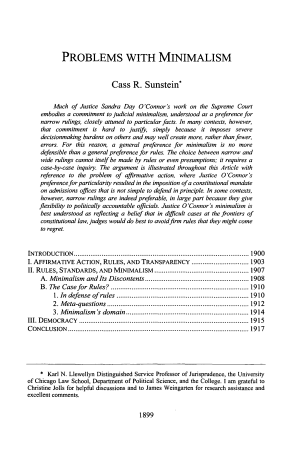Problems with Minimalism
April 2006

DISCLAIMER: This text has been transcribed automatically and may contain substantial inaccuracies due to the limitations of automatic transcription technology. This transcript is intended only to make the content of this document more easily discoverable and searchable. If you would like to quote the exact text of this document in any piece of work or research, please view the original using the link above and gather your quote directly from the source. The Sandra Day O'Connor Institute does not warrant, represent, or guarantee in any way that the text below is accurate.
Article Text
(Excerpt, Automatically generated)
PROBLEMS WITH MINIMALISM
Cass R. Sunstein*
Much of Justice Sandra Day O'Connor's work on the Supreme Court embodies a commitment to judicial minimalism, understood as a preference for narrow rulings, closely attuned to particular facts. In many contexts, however, that commitment is hard to justify, simply because it imposes severe decisionmaking burdens on others and may well create more, rather than fewer, errors. For this reason, a general preference for minimalism is no more defensible than a general preference for rules. The choice between narrow and wide rulings cannot itself be made by rules or even presumptions; it requires a case-by-case inquiry. The argument is illustrated throughout this Article with reference to the problem of affirmative action, where Justice O'Connor's preference for particularity resulted in the imposition of a constitutional mandate on admissions offices that is not simple to defend in principle. In some contexts, however, narrow rulings are indeed preferable, in large part because they give flexibility to politically accountable officials. Justice O'Connor's minimalism is best understood as reflecting a belief that in difficult cases at the frontiers of constitutional law.judges would do best to avoid firm rules that they might come to regret.
INTRODUCTION 1900
AFFIRMATIVE ACTION, RULES, AND TRANSPARENCY 1903
RULES, STANDARDS, AND MINIMALISM 1907
Minimalism and Its Discontents 1908
The Case for Rules? 1910
In defense of rules 1910
Meta-questio
